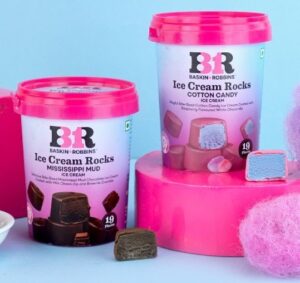Mohit Khattar, chief executive officer, Graviss Foods Pvt Ltd – Baskin Robbins gives the inside scoop on the ice cream brand’s three decades-long journey, expansion plans, and much more…
A flavour for each day of the month is how Baskin Robbins wooed ice cream lovers to its store when it first launched in Mumbai in 1993 with 31 flavours. Thirty years after the brand entered the Indian market through a master franchise agreement with the Graviss Group, it is available across more than 850 exclusive stores, hotels restaurants and catering (HoReCa) segments, hypermarkets, supermarkets and online.
 In an exclusive interaction with IndiaRetailing, Mohit Khattar, chief executive officer, Graviss Foods Pvt Ltd. – Baskin Robbins gives the inside scoop on the ice cream brand’s three-decades-long journey, expansion plans, and much more.
In an exclusive interaction with IndiaRetailing, Mohit Khattar, chief executive officer, Graviss Foods Pvt Ltd. – Baskin Robbins gives the inside scoop on the ice cream brand’s three-decades-long journey, expansion plans, and much more.
Tell us about 30 illustrious years of the brand in India.
With its initial launch in Mumbai in 1993, Baskin Robbins received love from consumers in the city which has only multiplied over the years.
In the first two decades, the brand only operated exclusive parlours. However, this changed a few years ago as we made the strategic call to expand our presence through the retail segment also. This was recognising the fact that, in India, more than 90% of the ice cream market at the time was dominated by general trade (GT) and pushcarts. Today, we are available across all leading national and regional supermarket chains.
Also, the brand remains in demand across food service and the HoReCa segment including hotels, airlines and multiplexes. We count leading hospitality brands among our consumers.
How has the business changed over the years?
Three decades ago, the concept of an ice cream parlour was relatively novel. Over the years, the concept has grown and so has our business model.
Earlier, all the sales were driven by footfall into the outlets. Now, take-home or home deliveries are popular due to their convenience factor.
Parlours no longer remain the sole business channel. Today, sales are also driven through retail, HoReCa and online channels, reflecting the evolving nature of retail in India.
The product options too have changed as we have launched products like ice cream cakes, shakes, and sundaes with a variety of accompaniments.
Marketing strategies have also moved from press, magazine and occasional TV advertisements to social and digital platforms.
What has remained unchanged though is our promise of pristine quality, 100% pure veg ingredients, our resolve to use only dairy ingredients and our offer of a 31% discount on every 31st of the month.
Tell us about the ice cream trends in India as compared globally.
Ice cream consumption in India is said to be around 400 ml per person per year whereas the US consumes 22 litres per person per year, China consumes 3 litres per person per year and Brazil is at 4.9 litres per person.
India seems to have entered a phase of rapid growth and consumption. In the next few years, we expect demand to grow at least 15-16% every year for the next couple of years. Our current industry is about Rs 18,000-odd crore, of which the organised industry is said to be only about Rs 5,500 crore.
Globally, there has been an increase in demand for dairy-free, vegan, low-calorie, healthy ice creams, while in India, the trend is only beginning to emerge now.
How has business been in recent years? Have there been changes in consumer preference?
Markets and consumers have rebounded sharply after the Covid scare diminished. The last two years have been robust for our business on multiple fronts—including our footprint growth, our sales revenues and growth across channels as well as for our bottom line. We have opened nearly more than 190 stores in the last two years and have grown at an average pace of 35% YOY.
We have also set up a new plant near Pune that gives us better control of our supply chain and helps improve our ability to meet the growing demand.
 In terms of consumer preferences, the Covid-19 period saw heightened concern over hygiene with a slant towards healthier product options but that has diminished slowly. Also, more consumers are now opting for a wholesome dessert experience rather than enjoying only ice cream scoops.
In terms of consumer preferences, the Covid-19 period saw heightened concern over hygiene with a slant towards healthier product options but that has diminished slowly. Also, more consumers are now opting for a wholesome dessert experience rather than enjoying only ice cream scoops.
In terms of buying behaviour, across categories, we have seen consumers demonstrating convenience-oriented decisions, thus, we have established our presence across all online platforms over the years.
Does seasonality affect your business? What are your expected sales and footfall for the summer season this year?
As an industry, ice creams see sharp seasonality with around 60% of the consumption being in the April to September period. The balance of 40% comes in during October to March when temperatures are relatively lower and the weather much cooler.
The last two years have seen us deliver record sales growth and volumes; we expect to grow at least another 15-20% over that with the addition of 17 new products across all our parlours.
What are your expansion plans?
We are present in more than 850 stores across 239 cities and towns in the country with a strong presence in major cities such as Mumbai, Delhi, Bangalore, Chennai, Hyderabad, Pune, and Kolkata.
We are also in the SAARC region with a presence in Nepal, Srilanka, and Maldives. Having 850 stores makes us the largest ice cream franchise in the region and the second-largest QSR operator in terms of network strength.
We expect to add 80-100 stores next year.
What omni-channel initiatives have you taken?
We have a strong presence on Swiggy and Zomato, which deliver from our parlours. Similarly, we are present on Instamart, Zepto and Bigbasket.
We also have our website where customers can get offers and quick deliveries. This is in addition to our offline presence with our exclusive parlours, our retail presence in leading GT and modern trade (MT) stores as well as the HoReCa accounts.
What technological advancements have you adopted?
Our modern Point of Sales(POS) systems across stores allow for faster and more efficient order processing, payment collection, and inventory management. We are also moving towards a best-in-class rewards and loyalty management system that allows us to segment consumers based on shopping behaviour across offline and online channels. Recently, we have introduced e-bills for consumers.
We are also shortly introducing platforms that will allow personnel across the company to collaborate and share information, training content and conduct audits, among other things, seamlessly.
What is the brand’s supply chain infrastructure?
Our supply chain infrastructure encompasses everything, right from managing our incoming raw materials, packaging material, as well as in-house storage and outbound logistics of finished goods.
We source our ingredients from local and international suppliers and store them in-house. Our state-of-the-art warehouses and cold rooms and dispatch infrastructure can manage the outbound movement of all our finished goods. Furthermore, we have established a strong network of distribution centers and logistics partners to ensure timely delivery to our parlours, retail stores and HoReCa accounts.




